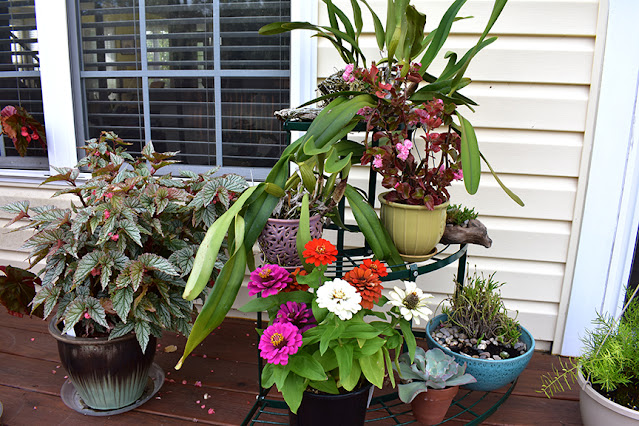 |
| Cardinal flower (Lobelia cardinalis) |
Today is Garden Bloggers' Bloom Day, hosted by Carol Michel's May Dreams Garden Blog. Here in the northwest corner of Virginia, my Zone 6b garden continues to suffer from the drought that has affected the entire Shenandoah Valley this year. Other parts of the state have received some relief lately with summer storms, but the storms have brought only a little in the way of water for my garden. This August we are still short of even one inch of rain with half the month already past!
 | |
| Another Cardinal flower (Lobelia cardinalis) |
 |
| Lobelia 'Starship Rose' |
The worst part is that with very little to browse in the forests, the wild creatures have been extremely voracious--both deer and rabbits have been making deeper inroads into my garden than ever before, leaving me few flowers to enjoy.
A newly planted Cardinal flower and the Lobelia 'Starship Rose' above had to be fenced off to protect them. After their tops got munched I could see that I'd have no flowers otherwise. The first photo is of one tiny cardinal flower that mysteriously popped up in the front yard--I have no recollection of having planted it there, but perhaps it came with some bee balm that I'd transplanted from somewhere else.
 |
| My front yard. |
The hardy begonias in the front yard have been decimated, I wonder if they'll have any flowers this year? The other plants along my front walk aren't exactly putting on a dazzling display, but there are a few exotic flowers among them, like my Cuban rain tree (Brunfelsia nitida) and the double Tuberoses in bud. I planted the Tuberoses last year, but they didn't bloom, and I'm waiting for the buds to open so I can inhale their lovely scent.
 |
| Cuban rain tree (Brunfelsia nitida) with a blossom. |
 |
| Double Tuberose buds. |
 |
| Salvias and tropical plants along the front walk. |
Other parts of the garden are looking pretty sad. I usually have spectacular display of blue Lobelias this month, but this year most of the buds have been eaten by deer, and only a few have escaped.
 |
| Blue Lobelia (Lobelia syphillitica) |
 |
| Blazing meadow star (Liatris ligulistylis) |
Only one spike of the Blazing Meadow Stars came up this spring, but it got eaten down, and only a few flowers have re-sprouted. The newly-planted Liatris 'Kobold' was eaten back too; that hasn't re-sprouted at all. The Stella de Oro daylily buds were eaten, as were all my other daylilies. Only now is one flower spike of Stella starting to rebloom.
 |
| Stella de Oro daylily. |
The potted plants on my porch and back deck are about the only ones the critters can't get to, and even they aren't exactly dazzling--just getting by, perhaps..
 |
| Hanging basket on porch. |
 |
| Plants on the front porch. |
 |
| Zinnias, orchids and begonias on the back deck. |
A yellow 'Benary's Giant' Zinnia I planted from seed has started to bloom--one of the few that made it, most got eaten, probably by rabbits.
 |
| Zinnia 'Benary's Giant' |
My Abelia 'Panoramic Color Radiance' has put forth one tiny flower spike, let's hope it will have a few more, but the plant's variegated foliage is so beautiful on its own, it may not need to flower.
 |
| Abelia 'Panoramic Color Radiance' |
The new bed with the Anise hyssop (Agastache foeniculum) grown from seed hasn't filled in yet, but there are a few plants in bloom. The ensemble with white salvia, mountain mint, a sedge and oat grass will look better as it fills in with time, and hopefully become a pollinator magnet.
 |
| White Salvia with sedge, slender-leaved mountain mint, oat grass and Anise Hyssop. |
 |
| Tomato harvest. |
This year the only thing that has flourished are my deck-grown tomatoes: Roma, cherry and yellow pear. Please pray for rain for our parched gardens in Virginia!























